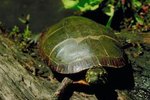Proper lighting is crucial for a captive yellow-bellied slider turtle's health. That doesn't mean you should keep a light on for him all night, but it should be on for part of that time. Yellow-bellied slider turtles spend a good deal of time in basking spots, which for captives must stay at the correct temperature through lighting. Your turtle does require a heater on, 24 hours a day, to keep his water at the right temperature.
Yellow-Bellied Slider Turtles
In their native habitat, the southeastern United States, yellow-bellied slider turtles (Trachemys scripta) dwell in wetlands, ponds and rivers. Full-grown female turtles' shells measure about 11 inches long, while the smaller male turtles' shells matures is approximately 8 inches at maturity. These turtles like company, so keep more than one in the tank. With good care -- including the right lighting -- your turtles can live 25 years or more in captivity.
Tank Lighting
You can use a standard ultraviolet-B light designed for reptiles for your turtle's tank. Place it within 1 foot of his basking area. Use a timer so the light is on for 10 uninterruped hours daily. The light should keep his basking area at a steady temperature of 80 degrees Fahrenheit. UVB lighting loses effectiveness over time, so replace yours at least twice annually. You can also use incandescent bulbs to provide complementary lighting.
Vitamin D Synthesis
If your yellow-bellied slider turtle doesn't receive sufficient UVB light, he won't be able to synthesize vitamin D. Without enough vitamin D, your turtle can't correctly metabolize calcium. This leads not only to issues with bone growth, but to a potentially fatal metabolic bone disease. On warm, sunny days, put your turtle outdoors in a safe, secure environment to soak up some natural vitamin D from the sun's rays. Indirect exposure, such as placing the tank near a window, doesn't provide enough vitamin D for your pet.
Other Considerations
If the temperature in the room in which you keep your turtle never falls below 75 degrees Fahrenheit, you don't need more than standard UVB lighting to keep the basking area warm. If the room temperature does fall lower, you'll need to provide additional lighting and a heat source for your turtle. Once temperatures drop into the 60s, turtles stop eating and become susceptible to respiratory ailments. Install all lighting and other electric elements carefully so they can't fall into the water.
References
Writer Bio
Jane Meggitt has been a writer for more than 20 years. In addition to reporting for a major newspaper chain, she has been published in "Horse News," "Suburban Classic," "Hoof Beats," "Equine Journal" and other publications. She has a Bachelor of Arts in English from New York University and an Associate of Arts from the American Academy of Dramatics Arts, New York City.





